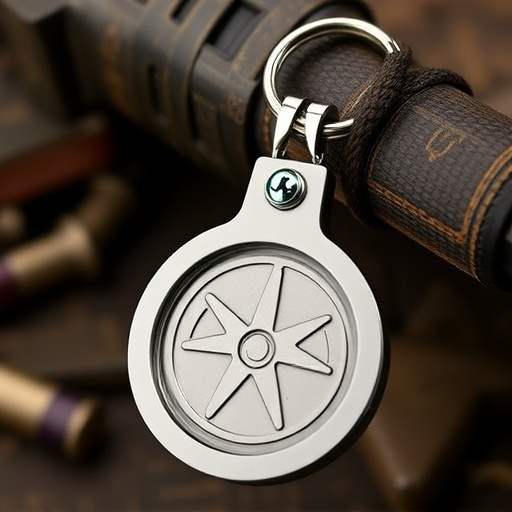Tactical keyring grip design for self-defense balances aesthetics and functionality, focusing on ergonomic shapes, textured surfaces, and durable materials for secure control in stressful situations. Legal considerations are paramount, as regional laws vary regarding prohibited keychain weapons listed by local authorities. Choosing a tactical keyring requires understanding these restrictions, prioritizing safety through proper training, responsible handling, and regular inspections while adhering to the Prohibited Keychain Weapons List.
“Unleash your personal safety with the innovative world of self-defense keyrings. This comprehensive guide explores tactical grip design, transforming everyday carry into a powerful defense. Understand the art of handling these compact tools and navigate legal considerations regarding prohibited keychain weapons. Discover unique features, from hidden blades to pepper spray dispensers, tailored for various needs. Learn essential training tips to ensure confidence and effectiveness in high-pressure situations. Equip yourself with knowledge, stay prepared, and know the local laws regarding prohibited keychain weapons.”
- Understanding Tactical Grip Design for Keyrings
- Legal Considerations: Prohibited Keychain Weapons
- Keyring Weapon Features and Functionality
- Choosing the Right Self-Defense Tool for Your Needs
- Training and Safety Tips for Effective Use
Understanding Tactical Grip Design for Keyrings
Tactical grip design for keyrings is more than just a stylish addition; it’s a strategic choice that enhances self-defense capabilities. These designs often incorporate ergonomic shapes, textured surfaces, and durable materials to ensure a firm, slip-resistant grasp. This is particularly crucial when a user needs to quickly deploy a self-defense tool in a stressful situation. By understanding the principles behind tactical grip design, individuals can make informed decisions when selecting or creating a keyring that’s more than just functional—it’s a potent defense against potential threats.
Knowing the Prohibited Keychain Weapons List is also essential, as it varies by region and legal jurisdiction. Tactical grip keyrings should always adhere to these regulations to avoid legal repercussions. Legitimate self-defense tools are designed with safety features and minimal capabilities, ensuring users can protect themselves without causing unnecessary harm or breaking the law. Thus, combining tactical grip design with compliance with local laws is paramount for any individual seeking a reliable and legal self-defense option on their keyring.
Legal Considerations: Prohibited Keychain Weapons
When considering self-defense keyring tactical grip designs, it’s crucial to understand the legal considerations surrounding prohibited keychain weapons. Different regions have varying laws regarding what constitutes a legal self-defense tool and what is strictly forbidden. In many places, certain types of keychain weapons are explicitly listed as prohibited items, including those with blades that can cause significant harm or have specific locking mechanisms.
The list of prohibited keychain weapons often includes knifes, machetes, switchblades, and other sharp objects designed for cutting or slicing. Additionally, tools with impact capabilities, such as certain types of batons or pepper spray dispensers, might also fall under restricted categories. It’s essential to familiarize yourself with local legislation to ensure that your chosen tactical keyring grip design adheres to legal boundaries, thereby avoiding potential consequences and ensuring personal safety.
Keyring Weapon Features and Functionality
A tactical keyring designed for self-defense should incorporate several key features, especially if its functionality is to be taken seriously. Firstly, it must feature a robust and durable construction, capable of withstanding rigorous use in high-stress situations. The grip should be ergonomically designed, allowing for a firm and secure hold, enhancing control during combat.
Moreover, the keychain weapon should include a reliable locking mechanism to prevent accidental deployment and ensure safety when not in use. Some models even incorporate sharp blades or spikes, offering additional defensive options, but these features are controversial due to legal restrictions on prohibited keychain weapons, such as those found on the Prohibited Keychain Weapons List. Nevertheless, the ability to transform from a regular keyring to a formidable defense tool is a significant selling point for tactical enthusiasts.
Choosing the Right Self-Defense Tool for Your Needs
Choosing the right self-defense tool is crucial, as it should align with your specific needs and preferences. In many places, a prohibited keychain weapons list outlines what’s allowed and what isn’t, so understanding local laws is essential before making a purchase. Consider factors like ease of use, portability, and the level of force required. For instance, a tactical grip keyring designed for self-defense offers both discreteness and effectiveness, fitting comfortably in your hand and easily accessible when needed.
Whether you prioritize a tool that can double as a last resort during an attack or one that provides peace of mind with its mere presence, the right choice should strike a balance between functionality and legality. Always remember that self-defense is about being prepared, not necessarily seeking conflict, so choosing the appropriate device for your circumstances is key to ensuring safety without overstepping legal boundaries.
Training and Safety Tips for Effective Use
Proper training is essential for anyone considering carrying a keychain weapon for self-defense. Before gripping that tactical keyring, familiarize yourself with local laws regarding prohibited keychain weapons and understand the safe handling procedures. Many self-defense enthusiasts opt for specialized training courses to learn effective techniques, ensuring they can use their keyring with precision and control.
When it comes to safety, always treat your tactical grip as a potential weapon. Keep it out of reach of children and avoid showing it off in public. Regularly inspect the keyring’s functionality and sharpness, ensuring it remains reliable for its intended purpose. Remember, proficiency comes with practice; train responsibly, stay aware of your surroundings, and respect others’ personal space to maximize the effectiveness of your self-defense tool.
The tactical keyring with a self-defense grip design offers a convenient and discreet way to enhance personal safety. While it’s essential to understand legal limitations on prohibited keychain weapons, knowing your rights and choosing the right tool can empower you. With proper training and safety measures, these compact devices can provide peace of mind in various situations. Remember, understanding local laws regarding Prohibited Keychain Weapons List is crucial before considering any self-defense tool, ensuring a responsible approach to maintaining your safety and that of those around you.
